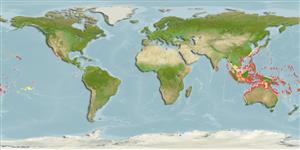>
Blenniiformes (Blennies) >
Tripterygiidae (Triplefin blennies) > Tripterygiinae
Etymology: Ceratobregma: Greek, keras = horn + Greek, bregma = the front of the head (Ref. 45335).
Environment: milieu / climate zone / depth range / distribution range
Ökologie
seewasser riff-verbunden; tiefenbereich 0 - 40 m (Ref. 27223). Tropical
Pacific Ocean: Christmas Island in the eastern Indian Ocean (Ref. 30874); Taiwan to southwestern and southeastern Australia and American Samoa.
Size / Gewicht / Alter
Maturity: Lm ? range ? - ? cm
Max length : 3.5 cm SL Männchen/unbestimmt; (Ref. 54980)
Kurzbeschreibung
Bestimmungsschlüssel | Morphologie | Morphometrie
Rückenflossenstacheln (insgesamt) : 18 - 20; Rückenflossenweichstrahlen (insgesamt) : 9 - 10; Afterflossenstacheln: 2; Afterflossenweichstrahlen: 19 - 21. Has a reddish head with rose blotches and an olive green body with irregular light streaks and blotches.
Eggs are hemispherical and covered with numerous sticky threads that anchor them in the algae on the nesting sites (Ref. 240). Larvae are planktonic which occur primarily in shallow, nearshore waters (Ref. 94114).
Life cycle and mating behavior
Maturities | Fortpflanzung | Spawnings | Egg(s) | Fecundities | Larven
Fricke, R., 1994. Tripterygiid fishes of Australia, New Zealand and the southwest Pacific Ocean (Teleostei). Theses Zool. 24:1-585. (Ref. 13227)
IUCN Rote Liste Status (Ref. 130435)
Bedrohung für Menschen
Harmless
Nutzung durch Menschen
Fischereien: nicht kommerziell
Tools
Zusatzinformationen
Download XML
Internet Quellen
Estimates based on models
Preferred temperature (Ref.
123201): 24.4 - 29, mean 27.8 °C (based on 656 cells).
Phylogenetic diversity index (Ref.
82804): PD
50 = 0.7500 [Uniqueness, from 0.5 = low to 2.0 = high].
Bayesian length-weight: a=0.00562 (0.00258 - 0.01228), b=3.08 (2.89 - 3.27), in cm total length, based on LWR estimates for this (Sub)family-body shape (Ref.
93245).
Trophic level (Ref.
69278): 3.1 ±0.3 se; based on size and trophs of closest relatives
Widerstandsfähigkeit (Ref.
120179): hoch, Verdopplung der Population dauert weniger als 15 Monate. (Preliminary K or Fecundity.).
Fishing Vulnerability (Ref.
59153): Low vulnerability (10 of 100).
Nutrients (Ref.
124155): Calcium = 455 [168, 1,781] mg/100g; Iron = 2.34 [0.84, 5.30] mg/100g; Protein = 18.1 [16.3, 19.8] %; Omega3 = 0.109 [0.027, 0.459] g/100g; Selenium = 73.3 [14.3, 319.4] μg/100g; VitaminA = 43.7 [6.1, 308.1] μg/100g; Zinc = 5.44 [2.43, 10.22] mg/100g (wet weight);
